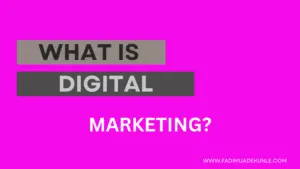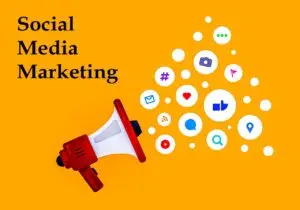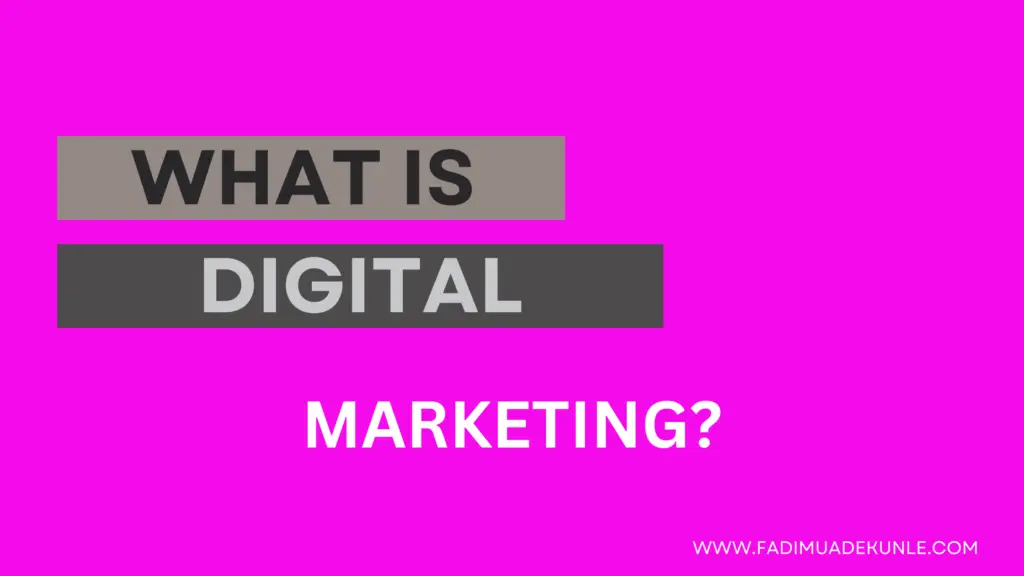
What is digital marketing?
What is digital marketing? In modern-day marketing, where technology permeates every aspect of our lives, businesses must adapt to stay relevant and competitive. One of the most significant adaptations is the shift from traditional marketing to digital marketing. Digital marketing leverages Internet and online-based digital technologies such as desktop computers, mobile phones, and other digital media platforms to promote products and services. This tutorial delves into the core aspects of digital marketing, offering a comprehensive understanding of its components, strategies, tools, and best practices.
The Evolution of Marketing
Traditional Marketing
Traditional marketing encompasses various forms of marketing and advertising that have been used for decades. These include print advertisements (newspapers, magazines), broadcast (television, radio), direct mail, telemarketing, and outdoor advertising (billboards, posters). While traditional marketing is still in use, its effectiveness has waned with the advent of the internet and digital technologies.
The Rise of Digital Marketing
Digital marketing emerged as a response to the changing media consumption habits of consumers. As the internet became more accessible and digital devices proliferated, marketers began exploring online platforms to reach their target audiences. The flexibility, measurability, and cost-effectiveness of digital marketing have made it an indispensable tool for businesses of all sizes.
What is digital marketing? Core Components of Digital Marketing
1. Search Engine Optimization (SEO)
SEO is the process of optimizing a website to rank higher in search engine results pages (SERPs). The goal is to increase organic (non-paid) traffic to the website. SEO involves several techniques, including keyword research, on-page optimization, off-page optimization, and technical SEO.
Keyword Research: Identifying the words and phrases potential customers use to search for products or services related to your business.
On-Page Optimization: Enhancing the content and HTML source code of a page to improve its relevance to specific keywords. This includes optimizing title tags, meta descriptions, headers, and content.
Off-Page Optimization: Building a website’s authority through backlinks from other reputable sites.
Technical SEO: Ensuring that a website meets the technical requirements of search engines, including site speed, mobile-friendliness, and secure connections (HTTPS).
2. Content Marketing
Content marketing involves creating and distributing valuable, relevant, and consistent content to attract and engage a clearly defined audience. The primary objective is to drive profitable customer action. Content can take various forms, including blog posts, articles, videos, infographics, podcasts, and social media posts.
Blogging: Regularly publishing articles on a website to provide valuable information, answer questions, and solve problems for the target audience.
Video Marketing: Creating videos to promote products, explain concepts, or entertain the audience. Platforms like YouTube, Vimeo, and social media channels are popular for video marketing.
Infographics: Using visual representations of information or data to present complex ideas clearly and concisely.
Podcasts: Audio content that can be streamed or downloaded, offering insights, interviews, or educational material.
3. Social Media Marketing

Social media marketing involves using social media platforms to promote products, services, or content. It encompasses both organic (unpaid) and paid strategies.
Organic Social Media Marketing: Building a community and engaging with followers through regular posts, updates, and interactions.
Paid Social Media Advertising: Running targeted ad campaigns on platforms like Facebook, Instagram, Twitter, LinkedIn, and Pinterest to reach specific demographics.
4. What is digital marketing? Pay-Per-Click (PPC) Advertising
PPC advertising is a model where advertisers pay a fee each time their ad is clicked. It’s a way to buy visits to your site rather than earning them organically. Google Ads is the most common PPC platform, but social media platforms also offer PPC advertising options.
Search Ads: Text ads that appear on search engine results pages when users search for specific keywords.
Display Ads: Banner, image, or video ads that appear on websites within the Google Display Network.
Social Media Ads: Sponsored posts or ads on social media platforms.
5. Email Marketing
Email marketing involves sending commercial messages to a group of people using email. It’s an effective way to nurture leads, keep customers engaged, and drive conversions.
Newsletters: Regular updates sent to subscribers, typically containing a mix of content, news, and promotions.
Promotional Emails: Emails sent to promote a specific product, service, or offer.
Automated Emails: Pre-scheduled emails triggered by specific actions or events, such as welcome emails, cart abandonment emails, and follow-up emails.
6. Affiliate Marketing
Affiliate marketing is a performance-based marketing strategy where businesses reward affiliates (partners) for bringing in customers through the affiliate’s marketing efforts. Affiliates earn a commission for each sale or lead they generate.
Affiliate Networks: Platforms that connect businesses with potential affiliates. Examples include Commission Junction, ShareASale, and Amazon Associates.
Affiliate Links: Unique tracking links used by affiliates to promote products or services.
7. Influencer Marketing
Influencer marketing involves partnering with individuals who have a significant following on social media or other online platforms. Influencers can help promote products or services to their audience in a more authentic and relatable manner.
Micro-Influencers: Individuals with a smaller but highly engaged following (usually between 1,000 and 100,000 followers).
Macro-Influencers: Individuals with a large following (usually over 100,000 followers).
Celebrity Influencers: Well-known public figures with massive followings.
What is digital marketing? Key Digital Marketing Strategies
1. Inbound Marketing
Inbound marketing focuses on attracting customers by creating valuable content and experiences tailored to them. It involves drawing customers in rather than pushing products or services onto them.
Content Creation: Developing high-quality, informative content that addresses the needs and interests of the target audience.
SEO: Optimizing content to make it easily discoverable through search engines.
Lead Nurturing: Using email marketing and marketing automation to guide prospects through the buyer’s journey.
2. Outbound Marketing
Outbound marketing involves reaching out to potential customers through various channels, often interrupting their regular activities. Traditional advertising methods like TV commercials, radio ads, and cold calling are examples of outbound marketing.
Paid Advertising: Using PPC, display ads, and social media ads to reach a broader audience.
Email Blasts: Sending promotional emails to many recipients.
3. Performance Marketing
Performance marketing is a results-driven approach where advertisers pay only when specific actions are completed, such as clicks, sales, or leads. This model is highly measurable and ensures a better return on investment (ROI).
Affiliate Marketing: Rewarding affiliates for driving conversions.
PPC Advertising: Paying for each click on an ad.
Social Media Ads: Paying for specific actions like video views, app installs, or lead form submissions.
4. What is digital marketing? Relationship Marketing
Relationship marketing focuses on building long-term relationships with customers to foster loyalty and repeat business. It emphasizes customer satisfaction and engagement over immediate sales.
Customer Service: Providing exceptional support and service to enhance customer satisfaction.
Loyalty Programs: Offering rewards and incentives for repeat purchases.
Personalized Marketing: Using data to deliver personalized experiences and offers.
Tools and Platforms in Digital Marketing
1. Google Analytics

Google Analytics is a powerful tool for tracking and analyzing website traffic and user behavior. It provides insights into how visitors find and interact with your site, which can help inform marketing strategies.
Audience Reports: Understanding the demographics, interests, and behaviors of your site visitors.
Acquisition Reports: Identifying which channels (organic search, social media, email, etc.) drive the most traffic.
Behavior Reports: Analyzing how users interact with your site, including page views, bounce rates, and conversions.
2. Google Ads
Google Ads is a PPC advertising platform that allows businesses to create and run ads on Google’s search engine and its advertising network.
Search Ads: Text ads that appear on search results pages.
Disp lay Ads: Visual ads that appear on websites within the Google Display Network.
Video Ads: Ads that run on YouTube and other video platforms.
3. Social Media Management Tools
Social media management tools help businesses manage, schedule, and analyze their social media activities.
Hootsuite: A platform for scheduling and managing social media posts across multiple networks.
Buffer: A tool for planning, scheduling, and publishing social media content.
Sprout Social: A comprehensive platform for social media management, monitoring, and analytics.
4. What is digital marketing? Email Marketing Platforms
Email marketing platforms enable businesses to create, send, and analyze email campaigns.
Mailchimp: A popular email marketing service that offers a range of features, including automation, segmentation, and analytics.
Constant Contact: An email marketing tool designed for small businesses, offering templates, automation, and reporting.
AWeber: A platform for creating and managing email marketing campaigns, with a focus on automation and analytics.
5. SEO Tools
SEO tools help businesses optimize their websites for search engines and improve their search rankings.
Ahrefs: A comprehensive SEO tool that offers keyword research, backlink analysis, and site audits.
SEMrush: A powerful platform for SEO, PPC, content marketing, and competitor research.
Moz: An SEO software suite that includes keyword research, link building, and site audits.
6. Content Management Systems (CMS)
A CMS allows businesses to create, manage, and publish digital content without needing technical expertise.
WordPress: The most popular CMS, known for its flexibility, ease of use, and extensive plugin ecosystem.
Drupal: A powerful CMS for building complex and scalable websites.
Joomla: A user-friendly CMS suitable for creating



You have remarked very interesting details! ps decent website.Blog money
I don’t understand what you mean
I can see a lot to gain from. Thanks so much
I was studying some of your content on this site and I think
this website is real informative! Keep putting up.Money from blog
Good to hear that. Thanks
https://bit.ly/krasiviy-seks-video-krasiviy-seks
Here are the explanation of digital marketing